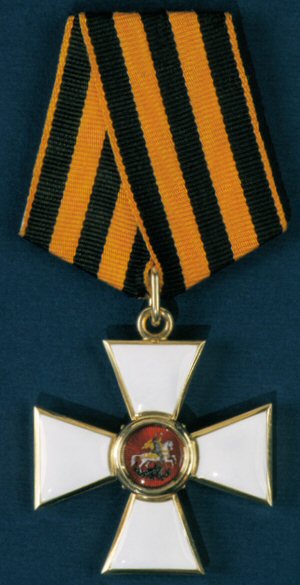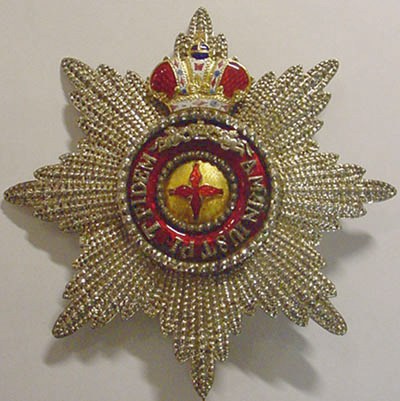|
Nikolai Ilyich Bulatov
Nikolai Ilyich Bulatov (born 21 January 1857) was an Imperial Russian corps commander. He took part in the wars against the Ottoman Empire and the Empire of Japan. Awards *Order of Saint Stanislaus (House of Romanov), 3rd class, 1878 *Order of Saint Anna, 3rd class, 1883 *Order of Saint Stanislaus (House of Romanov), 2nd class, 1901 *Order of Saint Anna, 2nd class, 1906 *Order of Saint Vladimir, 3rd class, 1907 *Order of Saint Stanislaus (House of Romanov), 1st class, 1911 *Order of Saint Vladimir, 2nd class, 1916 *Order of Saint George The Order of Saint George (russian: Орден Святого Георгия, Orden Svyatogo Georgiya) is the highest military decoration of the Russian Federation. Originally established on 26 November 1769 Julian (7 December 1769 Gregorian) a ..., 4th degree (October 30, 1916) {{DEFAULTSORT:Bulatov, Nikolai Ilyich Russian military personnel of the Russo-Turkish War (1877–1878) Russian military personnel of the Russo-Japanese W ... [...More Info...] [...Related Items...] OR: [Wikipedia] [Google] [Baidu] |
Russian Empire
The Russian Empire was an empire and the final period of the Russian monarchy from 1721 to 1917, ruling across large parts of Eurasia. It succeeded the Tsardom of Russia following the Treaty of Nystad, which ended the Great Northern War. The rise of the Russian Empire coincided with the decline of neighbouring rival powers: the Swedish Empire, the Polish–Lithuanian Commonwealth, Qajar Iran, the Ottoman Empire, and Qing China. It also held colonies in North America between 1799 and 1867. Covering an area of approximately , it remains the third-largest empire in history, surpassed only by the British Empire and the Mongol Empire; it ruled over a population of 125.6 million people per the 1897 Russian census, which was the only census carried out during the entire imperial period. Owing to its geographic extent across three continents at its peak, it featured great ethnic, linguistic, religious, and economic diversity. From the 10th–17th centuries, the land ... [...More Info...] [...Related Items...] OR: [Wikipedia] [Google] [Baidu] |
Order Of Saint Vladimir
The Imperial Order of Saint Prince Vladimir (russian: орден Святого Владимира) was an Imperial Russian order established on by Empress Catherine II in memory of the deeds of Saint Vladimir, the Grand Prince and the Baptizer of the Kievan Rus'. Grades The order had four degrees and was awarded for continuous civil and military service. People who had been awarded with the St. Vladimir Order for military merits bore it with a special fold on the ribbon – "with a bow". There was a certain hierarchy of Russian Orders. According to this, the First Class Order of Saint Vladimir was the second one—the first was the Saint George Order—by its significance. According to Russian laws on nobility, people who were awarded the Order of Saint Vladimir had the rights of hereditary nobility until the Emperor's decree of 1900 was issued. After this, only three first classes of the order gave such a right, the last one granting only personal nobility. Today, G ... [...More Info...] [...Related Items...] OR: [Wikipedia] [Google] [Baidu] |
Russian Military Personnel Of World War I
Russian(s) refers to anything related to Russia, including: *Russians (, ''russkiye''), an ethnic group of the East Slavic peoples, primarily living in Russia and neighboring countries *Rossiyane (), Russian language term for all citizens and people of Russia, regardless of ethnicity *Russophone, Russian-speaking person (, ''russkogovoryashchy'', ''russkoyazychny'') *Russian language, the most widely spoken of the Slavic languages *Russian alphabet * Russian cuisine *Russian culture *Russian studies Russian may also refer to: *Russian dressing *''The Russians'', a book by Hedrick Smith *Russian (comics), fictional Marvel Comics supervillain from ''The Punisher'' series *Russian (solitaire), a card game * "Russians" (song), from the album ''The Dream of the Blue Turtles'' by Sting *"Russian", from the album ''Tubular Bells 2003'' by Mike Oldfield *"Russian", from the album '' '' by Caravan Palace *Nik Russian, the perpetrator of a con committed in 2002 *The South African name for a ... [...More Info...] [...Related Items...] OR: [Wikipedia] [Google] [Baidu] |
Russian Military Personnel Of The Russo-Japanese War
Russian(s) refers to anything related to Russia, including: *Russians (, ''russkiye''), an ethnic group of the East Slavic peoples, primarily living in Russia and neighboring countries *Rossiyane (), Russian language term for all citizens and people of Russia, regardless of ethnicity *Russophone, Russian-speaking person (, ''russkogovoryashchy'', ''russkoyazychny'') *Russian language, the most widely spoken of the Slavic languages *Russian alphabet *Russian cuisine *Russian culture *Russian studies Russian may also refer to: *Russian dressing *''The Russians'', a book by Hedrick Smith *Russian (comics), fictional Marvel Comics supervillain from ''The Punisher'' series *Russian (solitaire), a card game * "Russians" (song), from the album ''The Dream of the Blue Turtles'' by Sting *"Russian", from the album ''Tubular Bells 2003'' by Mike Oldfield *"Russian", from the album '' '' by Caravan Palace *Nik Russian, the perpetrator of a con committed in 2002 *The South African name for a ... [...More Info...] [...Related Items...] OR: [Wikipedia] [Google] [Baidu] |
Russian Military Personnel Of The Russo-Turkish War (1877–1878)
Russian(s) refers to anything related to Russia, including: *Russians (, ''russkiye''), an ethnic group of the East Slavic peoples, primarily living in Russia and neighboring countries *Rossiyane (), Russian language term for all citizens and people of Russia, regardless of ethnicity *Russophone, Russian-speaking person (, ''russkogovoryashchy'', ''russkoyazychny'') *Russian language, the most widely spoken of the Slavic languages *Russian alphabet *Russian cuisine *Russian culture *Russian studies Russian may also refer to: *Russian dressing *''The Russians'', a book by Hedrick Smith *Russian (comics), fictional Marvel Comics supervillain from ''The Punisher'' series *Russian (solitaire), a card game * "Russians" (song), from the album ''The Dream of the Blue Turtles'' by Sting *"Russian", from the album ''Tubular Bells 2003'' by Mike Oldfield *"Russian", from the album '' '' by Caravan Palace *Nik Russian, the perpetrator of a con committed in 2002 *The South African name for a ... [...More Info...] [...Related Items...] OR: [Wikipedia] [Google] [Baidu] |
Alexander Lukomsky
Alexander Sergeyevich Lukomsky (10 July 1868 – 25 January 1939 in Paris) was a Russian military commander, General Staff, Lieutenant-General (April 1916). He fought for the Imperial Russian Army during the First World War and was one of the organizers of Volunteer army during the Russian Civil War. Lukomsky graduated from Nikolayev Engineering Institute as a military engineer, now Military engineering-technical university The Saint Petersburg Military Engineering-Technical University (Nikolaevsky) (russian: Санкт-Петербургский Военный инженерно-технический университет, VITU), previously known as the Saint Pet ... (Russian: Военный инженерно-технический университет). Lukomsky fought alongside Anton Denikin during the Russian Civil War and visited Grand Duke Nikolai Nikolaevich of Russia (1856–1929), Nikolai Romanov, one of the pretenders to the Tzarist throne following the Ia ... [...More Info...] [...Related Items...] OR: [Wikipedia] [Google] [Baidu] |
Vasily Timofeyvich Gavrilov
Vasily Timofeyvich Gavrilov (born 6 March 1867) was division and corps commanderin the military of the Russian Empire. He fought in the war against the Japanese Empire. He was promoted to Polkovnik in 1905 and major general in 1911. Awards *Order of Saint Stanislaus (House of Romanov), 2nd class, 1902 *Order of Saint Anna, 2nd class, 1904 *Order of Saint George, 4th degree, 1905 *Order of Saint Vladimir, 4th class, 1905 *Order of Saint Vladimir, 3rd class, 1909 *Gold Sword for Bravery The Gold Sword for Bravery (russian: Золотое оружие "За храбрость") was a Russian award for bravery. It was set up with two grades on 27 July 1720 by Peter the Great, reclassified as a public order in 1807 and abolished ..., 1904 Sources Русская императорская армия: Биографии Гаврилов, Василий Тимофеевич {{DEFAULTSORT:Gavrilov, Vasily Russian military personnel of the Boxer Rebellion Russian military ... [...More Info...] [...Related Items...] OR: [Wikipedia] [Google] [Baidu] |
Order Of Saint George
The Order of Saint George (russian: Орден Святого Георгия, Orden Svyatogo Georgiya) is the highest military decoration of the Russian Federation. Originally established on 26 November 1769 Julian (7 December 1769 Gregorian) as the highest military decoration of the Russian Empire for commissioned officers and generals by Empress Catherine the Great.Hurley, C. ''Russian Orders, Decorations, and Medals Under the Monarchy''. Harrison & Sons., Ltd., London. 1935. After the October Revolution in 1917, it was awarded by the White movement under Alexander Kolchak until their collapse in 1921. The order was revived in the Russian Federation on 8 August 2000 by Decree №1463 of the President of Russia. The current award criteria were amended on 7 September 2010 by Presidential Decree 1099. Statute of the Order of St. George The current Order of Saint George is awarded to highest and senior military officers for the conduct of military operations to protect the M ... [...More Info...] [...Related Items...] OR: [Wikipedia] [Google] [Baidu] |
Order Of Saint Anna
The Imperial Order of Saint Anna (russian: Орден Святой Анны; also "Order of Saint Anne" or "Order of Saint Ann") was a Holstein ducal and then Russian imperial order of chivalry. It was established by Karl Friedrich, Duke of Holstein-Gottorp, on 14 February 1735, in honour of his wife Anna Petrovna, daughter of Peter the Great of Russia. Originally, the Order of Saint Anna was a dynastic order of knighthood; but between 1797 and 1917 it had dual status as a dynastic order and as a state order. The Order of St. Anna continued to be awarded after the revolution by Grand Duke Kirill Vladimirovich, Grand Duke Vladimir Kirillovich, and Grand Duchess Maria Vladimirovna. Today, the Russian Imperial Order of St. Anna, awarded by Grand Duchess Maria Vladimirovna is recognized as an order of chivalry by the privately operated ICOC as a continuation of the pre-Revolutionary order, and has been approved for wear with military uniform by the Russian Federation, but not by s ... [...More Info...] [...Related Items...] OR: [Wikipedia] [Google] [Baidu] |
Imperial Russian Army
The Imperial Russian Army (russian: Ру́сская импера́торская а́рмия, tr. ) was the armed land force of the Russian Empire, active from around 1721 to the Russian Revolution of 1917. In the early 1850s, the Russian Army consisted of more than 900,000 regular soldiers and nearly 250,000 irregulars (mostly Cossacks). Precursors: Regiments of the New Order Russian tsars before Peter the Great maintained professional hereditary musketeer corps known as '' streltsy''. These were originally raised by Ivan the Terrible; originally an effective force, they had become highly unreliable and undisciplined. In times of war the armed forces were augmented by peasants. The regiments of the new order, or regiments of the foreign order (''Полки нового строя'' or ''Полки иноземного строя'', ''Polki novovo (inozemnovo) stroya''), was the Russian term that was used to describe military units that were formed in the Tsardom of Russi ... [...More Info...] [...Related Items...] OR: [Wikipedia] [Google] [Baidu] |



